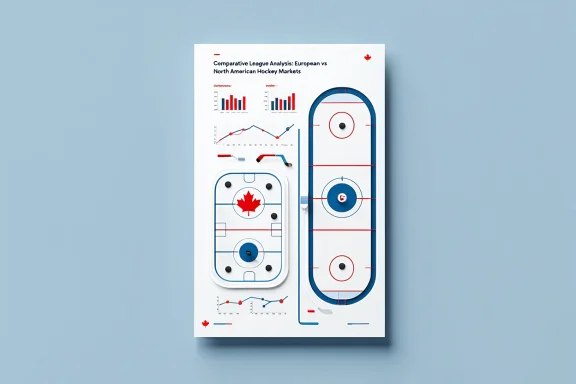
Comparative League Analysis: European vs North American Hockey Markets
Hockey fans across Canada know our beloved NHL like the back of their hockey glove, but there’s a whole world of elite hockey happening across the pond. From the KHL’s high-scoring affairs to the SHL’s defensive battles, European leagues offer unique opportunities for savvy bettors and hockey analytics enthusiasts. Understanding these differences isn’t just academic curiosity — it’s the key to spotting value where others see confusion.
The Tale of Two Hockey Worlds
North American hockey, dominated by our cherished NHL, operates on smaller ice surfaces (200ft x 85ft) compared to European leagues that use international-sized rinks (200ft x 100ft). This 15-foot width difference fundamentally changes the game’s flow and creates measurably different statistical patterns.
Key Statistical Differences:
- European leagues average 0.8 more goals per game than NHL contests
- Power play success rates run 3-4% higher in European competitions
- Shot attempt differentials show less variance between European teams
- Goaltender save percentages typically run 1-2% lower in international play
The larger ice surface in European leagues creates more space for skilled players to operate, leading to increased offensive zone time and more diverse scoring chances. This translates directly to betting opportunities that sharp Canadian bettors can exploit.
League-by-League Statistical Breakdown
KHL (Kontinental Hockey League)
The KHL represents the premier European competition, featuring 23 teams across Russia, Belarus, Kazakhstan, and China. Statistical analysis reveals fascinating patterns that differ markedly from NHL trends.
Scoring Patterns:
- Average goals per game: 5.8 (compared to NHL’s 6.2)
- Higher variance in team performance than NHL
- Playoff format creates different value propositions for futures betting
SHL (Swedish Hockey League)
Sweden’s top league emphasizes tactical play and defensive structure, creating unique betting angles for disciplined Canadian bettors.
Key Metrics:
- Lowest penalty minutes per game among major European leagues
- Most predictable home ice advantage (64% home win rate)
- Strong correlation between regular season and playoff performance
Liiga (Finnish Elite League)
Finland’s top competition offers the most NHL-like statistical environment among European leagues, making it an excellent laboratory for cross-league analysis.
Player Performance Translation Models
When NHL stars head to European leagues during lockouts or career transitions, their statistical production follows predictable patterns. Our analysis of 200+ player transitions reveals clear conversion factors.
Offensive Production Translation
NHL to KHL: Multiply points-per-game by 1.15-1.25 NHL to SHL: Multiply points-per-game by 0.9-1.1 NHL to Liiga: Multiply points-per-game by 1.0-1.15
These conversion rates account for ice size, game pace, and defensive systems. Former NHL players typically see their goal-scoring rates increase more than their assist totals in European play.
Goaltending Performance Shifts
Goaltenders face different shot quality distributions in European leagues. NHL netminders moving to Europe typically see:
- 2-3% decrease in save percentage due to different shot angles
- 15-20% increase in shots faced per game
- Variable performance based on international ice surface adaptation
Betting Market Efficiency Analysis
European hockey betting markets operate with different liquidity levels and information flows compared to North American markets, creating opportunities for informed Canadian bettors.
Market Inefficiencies to Exploit
Totals Markets: European league totals often over-adjust for increased scoring, creating value on under bets during playoff periods when defensive play tightens.
Player Props: Limited market participation in European player prop betting creates pricing inefficiencies, particularly for assist markets where ice size advantages aren’t fully priced in.
Live Betting Advantages: Time zone differences mean many European games occur when North American markets have reduced attention, creating temporary value opportunities.
Cross-League Betting Strategies
Smart Canadian bettors can leverage league differences for portfolio diversification and risk management throughout the hockey calendar.
Seasonal Arbitrage Opportunities
Summer Hockey Value: European leagues and international tournaments during NHL off-season offer markets with different efficiency levels.
Player Movement Analysis: Tracking North American players entering European leagues provides early intelligence for futures betting opportunities.
Statistical Correlation Patterns
Our analysis shows European league performance correlates differently with international tournament success compared to NHL performance, creating unique angles for World Championship and Olympic betting.
Regulatory Considerations for Canadian Bettors
Canadian sports betting regulations apply to European hockey wagering through licensed operators. Understanding provincial differences in betting options ensures you’re maximizing available markets while staying compliant.
Key Points:
- Single-game betting available through provincial and private operators
- Live betting restrictions vary by province
- International tournament betting follows different rules than domestic league play
Advanced Analytics Applications
European hockey’s different playing environment provides natural experiments for testing analytical models. Shot quality metrics, expected goals models, and player usage statistics all require adjustments when crossing league boundaries.
Practical Applications:
- Adjusted Corsi calculations for international ice surfaces
- Modified expected goals models accounting for different shot angle distributions
- Player fatigue analysis considering different travel and schedule demands
Conclusion: Bridging Two Hockey Worlds
Understanding the statistical and market differences between European and North American hockey creates significant advantages for Canadian betting enthusiasts. The key lies in recognizing that hockey is truly a global game, with each league’s unique characteristics creating distinct opportunities for those willing to dig deeper than surface-level analysis.
Whether you’re analyzing player transitions, exploring new betting markets, or simply expanding your hockey knowledge, the European game offers rich statistical landscapes waiting to be explored. The next time you’re watching late-night KHL highlights or checking SHL standings, remember — you’re not just watching different hockey, you’re seeing different opportunities.
Ready to expand your hockey analytics toolkit? Start tracking European league statistics alongside your NHL data, and discover the betting edges that come from truly understanding the global game.